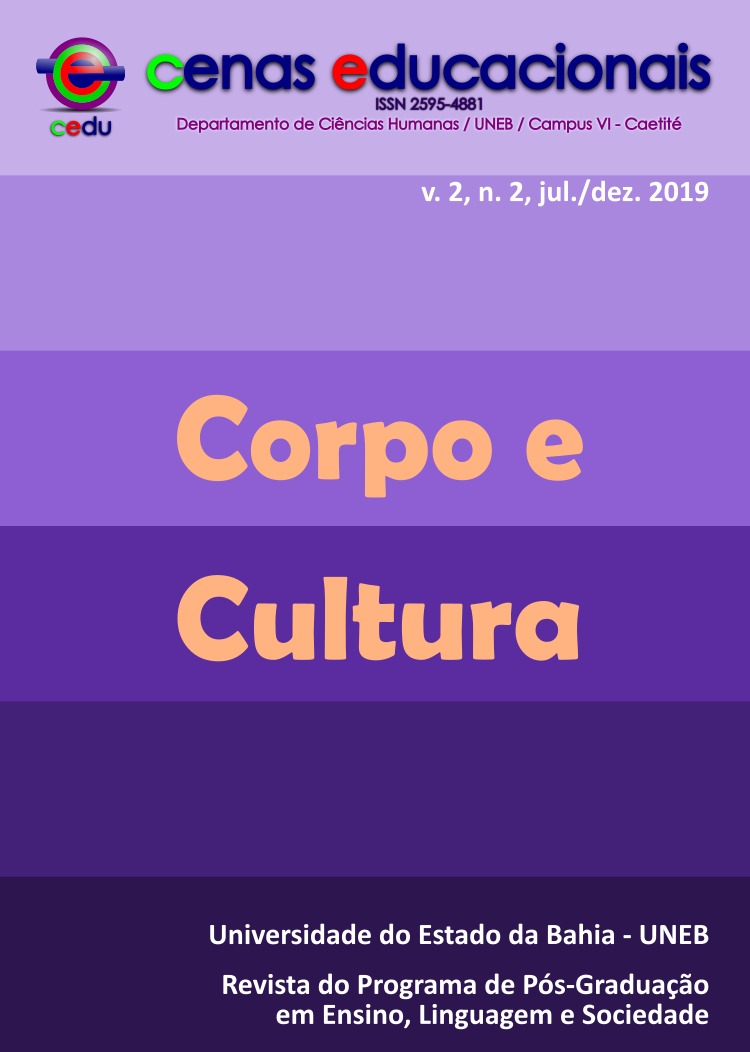THE PERFORMANCES OF BODIES DANCING ON THE STREET: DRAMATIC NARRATIVES ON VIDEO GOES ON HORSE
Keywords:
it dances, culture, daily.Abstract
They are about the directions produced for one of video in which a couple dances intitled music “Vai in the Pony”, that “it viralizou” in the Internet in 2013, carrying out scenes of daily the urban one. For in such a way, hand of the Fraps program is launched that it makes possible to transform the image-movement into photographs. The challenge of the writing is in the analysis of the performances and corporal statements presented by the pair, in the audiovisual, the form of proper aesthetic powers of the dance. Thus therefore, for the ways of a rizomático thought, the text invests in the composition of expressivas forms for translation of a mosaic of languages and gestures. A body-pony, as “Body without agencies” (Deleuze and Guattari), gains prominence while territory of ticket to know corporal through the collective dimension of the art, and the signs that if multiply in connections in the festive events, to produce the daily one of anonymous personagesDownloads
References
BAKHTIN, M. A cultura popular na Idade Média e no Renascimento: o contexto de François Rabelais. 4ª ed. São Paulo-Brasília: Hucitec,1999.
BIGBIG, T.; COELHO, S. Vai no cavalinho. Bahia: WS Edições Musicais, 2013.
Casal dançando “Vai no Cavalinho”. Disponível em:http://www.youtube.com/watch?v=LgqJXR7-4jk. Acessado em 23/01/2013 à 23:00hs.
CERTEAU, M. A invenção do cotidiano: 1, Artes de fazer. Petrópolis: Vozes, 2013.
DELEUZE, G. Conversações. Rio de Janeiro: Ed. 34, 1992.
DELEUZE, G.; GUATTARI, F. O que é filosofia. Rio de Janeiro: Ed. 34, 1992.
DELEUZE, G.; GUATTARI, F. Mil Platôs. Capitalismo e esquizofrenia. Volume 4. Rio de Janeiro: Ed. 34, 1997
GIL, J. N. Abrir o corpo. In: FONSECA, T. M. G.; ENGELMAN. S. (Org.). Corpo, arte e clínica. Porto Alegre: Editora da UFRGS, 2004.
GIL, J. N. O Corpo Paradoxal. Território da Filosofia 2015 disponível em https://territoriosdefilosofia.wordpress.com/2015/04/22/o-corpo-paradoxal-jose-gil/
GUERREIRO, G. A trama dos tambores: a música afo-pop de Salvador. São Paulo, Editora 34, 2000.
GUMBRECHT, H. U. Elogio da beleza atlética. São Paulo: Companhia das Letras, 2007. p. 62.
FERREIRA, J. P. “Leituras de presença e ausência: Textos noturnos e diurnos”. In: Cartografias da voz: poesia oral e sonora: tradição e vanguarda. São Paulo: Letra e Voz; Curitiba: Fundação Araucária, 2011.
MATTOS, I. G. É prá descer quebrando: o pagode e suas performances para a educação das relações etnicorraciais no currículo escolar.Tese de Doutorado, 227fl . 2013. Faculdade de Educação e Contemporaneidade, Universidade Estadual da Bahia, Salvador, 2013.
MORIN, E. Cultura de massas no século XX: o espírito do tempo. 6 ed. Rio de Janeiro: Forense-Universitária, 1984.
MORIN, E. O enigma do homem. Rio de Janeiro: Zahar editora, 1975.
NÓBREGA, P. N. Corporeidade e Educação Física:do corpo sujeito ao corpo objeto.Natal: EDUFRN, 2001.
NOVAES, S. C. O uso da imagem na antropologia. In: SAMAIN, E. (org) O Fotográfico. São Paulo, Hucitec, 1998.
PEIXOTO, C. E. Caleidoscópio de imagens: uso do vídeo e a sua contribuição à análise das relações sociais In: FELDMAN-BIANCO, B.; LEITE, M. L. M. (orgs.). Desafios da Imagem: fotografia, iconografia e vídeo nas ciências sociais. Campinas: Papirus, 1998.
SABINO, J.; LODY, R. Danças de Matriz Africana: antropologia do movimento. Rio de Janeiro: Pallas, 2011.
SODRÉ, M. A verdade seduzida. Por um conceito da cultura no Brasil. 2 ed. Rio de Janeiro: Francisco Alves, 1988.
SODRÉ, M. O terreiro e a cidade: a forma social negro-brasileira. Petrópolis:Vozes, 1988.
THOMPSON. J. B. Ideologia e cultura moderna: Teoria social crítica na era dos meios de comunicação de massa. Petrópolis: Vozes, 1995.
ZUMTHOR, P. Performance, recepção, leitura. São Paulo: Cosac Naify, 2007.
Published
How to Cite
Issue
Section
License
Copyright
The submission of originals to Cenas Educacionais (Educational Scenes - CEDU) implies the transfer, by the authors, of the publication rights. The copyright for the manuscripts published in this journal is the author(s), with CEDU rights over the first publication. Authors(s) may only use the same results in other publications by explicitly indicating CEDU as the means of the original publication.
Creative Commons License
Except where otherwise specified, the terms of a Creative Commons Attribution-ShareAlike 4.0 International License license apply to the material published in this journal, which allows unrestricted use, distribution and reproduction in any medium provided the original publication is correctly cited.






 This work is licensed with a License
This work is licensed with a License 